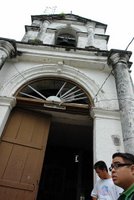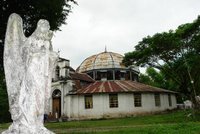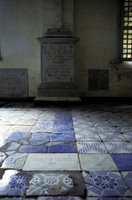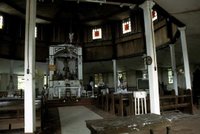 When I was still City Tourism Officer of San Fernando, Pampanga, I lamented the fact that the beautiful churches of Pampanga were not given the attention they truly deserve during the Holy Thursday visita iglesia tours. Well, I can say that today that Pampanga is hot on the visita iglesia map!
When I was still City Tourism Officer of San Fernando, Pampanga, I lamented the fact that the beautiful churches of Pampanga were not given the attention they truly deserve during the Holy Thursday visita iglesia tours. Well, I can say that today that Pampanga is hot on the visita iglesia map!On top of the list is the Betis Church in Guagua. A National Cultural Treasure, the church is called the Sistine Chapel of the Philippines because of its wall to ceiling mural paintings and its ornate wooden retablo.
You can start your visita iglesia in Lubao Church, the oldest church in Pampanga. From the San Fernando Exit of the NLEX, just drive westward to Lubao. After Lubao, drive eastward along the Jose Abad Santos Highway (Gapan-Olongapo Road) and look for the junction to Sta. Rita town on the left to visit the Sta. Rita Church. After there, you can drive to the Guagua Church, and then to Betis Church.
 After Betis, drive along the old National Highway until you reach Bacolor Church. Once the biggest church in Pampanga, it is now half-buried under lahar. But that did not damped the pride of the town in their heritage since they dug up the wonderful retablos and restored them.
After Betis, drive along the old National Highway until you reach Bacolor Church. Once the biggest church in Pampanga, it is now half-buried under lahar. But that did not damped the pride of the town in their heritage since they dug up the wonderful retablos and restored them.After Bacolor, continue your drive along the old National Highway until you reach San Fernando. You'll know you're in San Fernando when you see the chimneys of PASUDECO, the Pampanga Provincial Capitol, and the wonderful ancestral mansions along Consunji Street. Since Holy Thursday is also Araw ng Kagitingan, you might want to make a stopover at the San Fernando Train Station, an important Death March landmark.
 Anyway, you'll be able to find the Metropolitan Cathedral of San Fernando really easily. The current interior of the Cathedral was designed by Architect Fernando Ocampo after the church burned down a second time in 1939.
Anyway, you'll be able to find the Metropolitan Cathedral of San Fernando really easily. The current interior of the Cathedral was designed by Architect Fernando Ocampo after the church burned down a second time in 1939.Since you are already in San Fernando, you can have your lunch stop there and try out the great restaurants that serve some of the best Kapampangan fare.



 From San Fernando, drive south along MacArthur Highway to the Minalin Church and Apalit Church. Then at the San Simon Interchange, cross above the NLEX eastward to get to the San Luis Church and further on, the Arayat Church. Along the way, you'll see the old facade of the Sta. Ana Church. However, its interior is heavily renovated.
From San Fernando, drive south along MacArthur Highway to the Minalin Church and Apalit Church. Then at the San Simon Interchange, cross above the NLEX eastward to get to the San Luis Church and further on, the Arayat Church. Along the way, you'll see the old facade of the Sta. Ana Church. However, its interior is heavily renovated.
 If there's not enough time, you can go straight to Angeles Church north of San Fernando. From there, you could drive to Porac which has two old chapels worth visiting, the Pio Chapel and Hacienda Dolores Chapel. Pio is a bit more accessible. But it's quite a drive to Hacienda Dolores.
If there's not enough time, you can go straight to Angeles Church north of San Fernando. From there, you could drive to Porac which has two old chapels worth visiting, the Pio Chapel and Hacienda Dolores Chapel. Pio is a bit more accessible. But it's quite a drive to Hacienda Dolores.You can end your day with dinner in the Clark Freeport area which has a wonderful selection of international cuisine for all. Well, if your stomach is up to it, you can keep on eating in between churches since every town has its own specialty! A visita iglesia in Pampanga is definitely a feast for mind, body and soul!
Related entries
Visita iglesia to our heritage churches
Pisamban... the churches of Pampanga
Holy Week practices in the Philippines
Visita iglesia and more Holy Week practices in the Philippines
Visita iglesia routes for Holy Thursday






